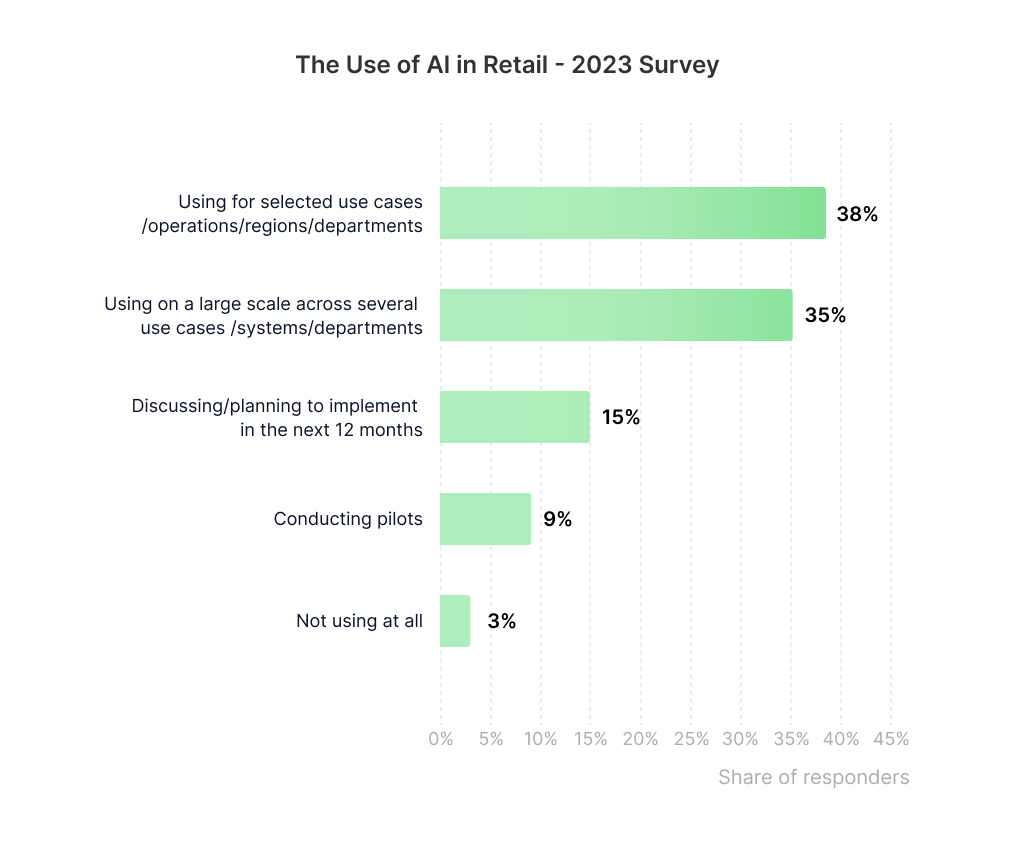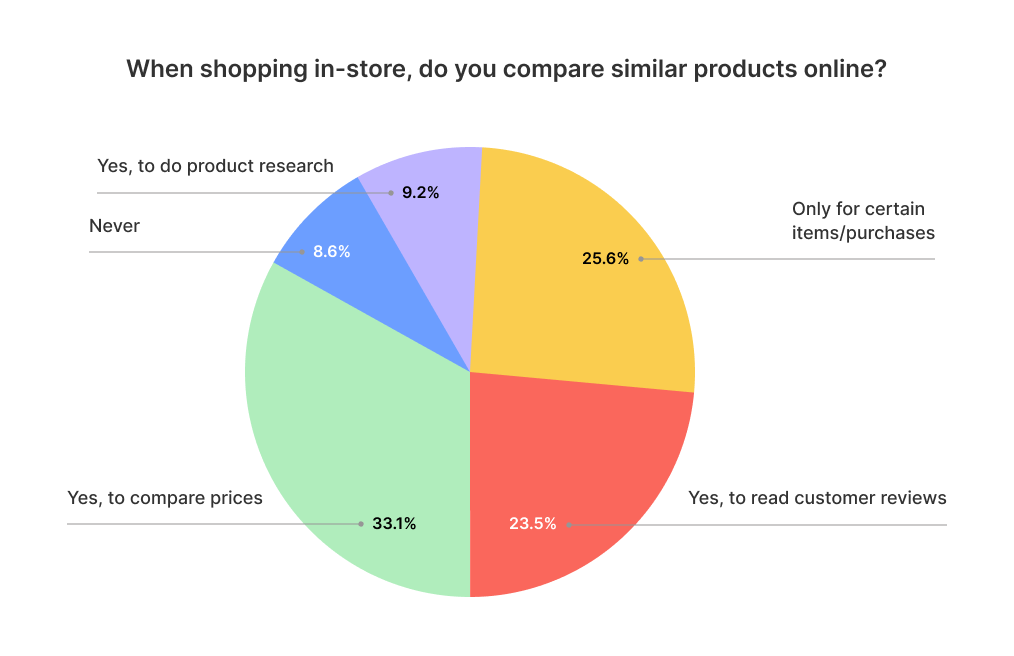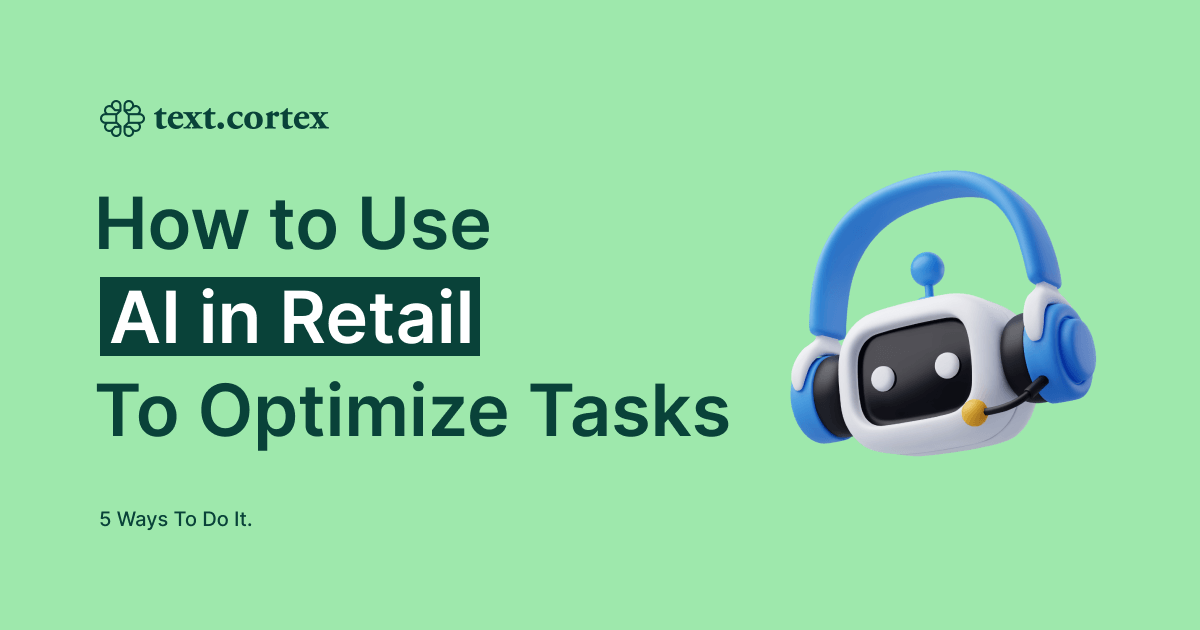It doesn't matter whether it's in-store or online retail, it's very difficult to keep track of stock, workers, prices, and market trends at the same time. That's why retailers have thousands of employees to do those jobs.
But wouldn't it considerably reduce the workload if they had a machine that could assist them in avoiding mistakes and making better business decisions? That is exactly what we will discuss in this article.
We'll go over 5 ways on how to use AI in retail to optimize tasks, including examples from well-known retailers. Let’s dive in!
Why You Should Use Artificial Intelligence (AI) in the Retail Industry?
In a 2023 poll conducted in the United States and the EMEA region, approximately 40% of retail directors said they used AI, CV, and MV for certain operations and divisions.
Another 35% of respondents claimed that they have already scaled up this type of technology, with 15% of questioned retail directors predicting that it would be adopted within the following year.

In the retail industry, you have to maintain profitability and productivity in order to stay competitive in the global market.
To do that, you have to make quick and decisive actions. AI tools can assist in this, with an opportunity to boost profitability and streamline business processes.
Overall, AI can help you make informed decisions about staffing and replenishment, optimize labor and inventory expenses, reduce stockouts, and maximize sales opportunities.
What Are the Benefits of AI in the Retail Industry?
✔️Fraud detection - AI algorithms can spot irregularities in transaction and behavior patterns. This helps retailers prevent fraud, such as identity theft and payment scams, safeguarding both customers and businesses.
✔️Operational efficiency - AI automates repetitive tasks like data input and customer questions.
✔️Informed decision-making - AI can obtain important insights from massive amounts of data, allowing retailers to make decisions about pricing, marketing methods, and product assortment.
✔️Improved inventory management - AI-powered tools can evaluate data to manage inventory levels, decreasing stockouts and overstocking.
How to Use AI in Retail To Optimize Tasks?
Let’s see how to use AI with practical use cases.
1. Use AI for Customer Support
One way to use AI in the retail industry is customer support. Customers are clearly the key to retail success, yet delighting everyone and resolving every problem may be challenging, particularly for large businesses.
This is why 63% of retailers have already used AI to improve their customer service. It won’t only improve buyer’s happiness but also free up valuable resources, allowing retailers to focus on more important areas of their operations.
How to Use AI in Customer Support?
🤖Use customer service chatbots - Chatbots are a common type of AI used for customer support that the average customer encounters. They can answer frequent questions with pre-set responses or by scanning manuals and websites.
🤖Organize messages - AI can automatically categorize and assign tickets to agents while continuously changing their sorting and labeling methods to ensure efficient resolution procedures.
🤖Provide multilingual support - AI tools can automatically detect the language of incoming messages and translate it into the agent’s language or vice versa. Additionally, some of these tools have speech translation functionality.
Use Case - H&M
H&M, for example, has integrated AI-powered chatbots into its customer support services.
It helps with a variety of issues, such as purchase tracking, returns, and sizing questions. Furthermore, H&M's AI chatbot provides style advice; it engages consumers by presenting two photographs and asking them to select their favorite style.
Users may also save, share, and search for outfits using this tool, which smoothly takes them to the H&M website to complete their purchase.
💡ProTip
TextCortex can help you in improving your customer service! Its feature Zeno works smoothly with popular customer support tools such as Zendesk, Intercom, Freshdesk, Groove, and more.
Simply copy and paste the customer's message into our TextCortex Chrome Extension's instant reply template. Provide brief instructions for correcting the issue, and Zeno will create a detailed email for you in no time.
2. Use AI to Improve Your Descriptions in Online Retail
Product descriptions are important in online retail because they include critical information such as features, specifications, and usage instructions. They also highlight the unique benefits of items, distinguishing them from competitors, which can lead to attracting potential customers.
How to Use AI in Writing Product Descriptions?
🤖Gather Data - AI can gather information from a variety of sources, such as product specifications, user reviews, and competitor descriptions.
🤖Generate Content - AI tools may develop descriptive content based on analyzed data, resulting in unique and captivating product descriptions that resonate with your target audience.
🤖Perform A/B testing - You can use AI-powered tools to perform A/B testing on various descriptions to see which ones perform the best in terms of conversion rates and consumer engagement.
Use Case - Target
Target Australia handles a large inventory across various categories, yet creating appealing product descriptions for thousands of items was a huge difficulty. To address this issue, this company turned to artificial intelligence (AI) to streamline content creation. It allowed them to write bulk product descriptions more quickly and effectively, which led to increased productivity without sacrificing quality.
💡ProTip
With ZenoChat, you can craft captivating product descriptions in minutes! This tool lets you generate compelling text with minimal input, and the best part is that you can customize the persona to match your brand's voice.
Simply provide key details about your product, such as features and a brief description, and ZenoChat will do the rest.
3. Use AI to Help Your Employees
The quality of your service or product relies on your employees' performance, with each worker contributing significantly to customer satisfaction. For example, in a large store setting like Walmart, it's challenging to track every item's location, colleague shifts, and precise inventory count.
However, it is critical to avoid empty shelves, which might upset customers. This is where AI can help your staff by providing the necessary support and information.
How to Use AI to Help Your Employees?
🤖Use AI for quick search - Staff frequently struggle to access relevant information fast, whether it is regarding product specifications, inventory, policies, or buyer's feedback. AI increases search functionality in retail systems, allowing employees to get answers without exploring complicated databases.
🤖Use AI as an HR bot - When employees encounter a situation where they require immediate clarification on HR rules, an AI tool can help them. Implementing an HR bot allows employees to easily get answers to their inquiries at any time, whether it's about notifying the boss before a day off or any other HR-related request. This saves them the trouble of writing lengthy emails to HR and ensures they obtain the information they require quickly.
Use Case - Walmart
Let’s take Walmart, for example. Their voice assistant, "Ask Sam," provides a variety of features for in-store staff members. It allows tasks like locating things, accessing store maps, checking prices and sales, reviewing messages, and more by asking questions like "Where can I find hand soap?" or "Who's working in the apparel department today?" and "Could you tell me my schedule for tomorrow?"
4. Use AI for Inventory Management
Running out of products results in lost sales and unhappy consumers. Overstocking ties up money and increases storage costs. Since you're losing money, it's difficult to say which is worse. To avoid this, retailers use AI technology to manage inventories and keep them at the optimum level.
How to Use AI for Inventory Management?
🤖Incorporate real-time inventory tracking - AI can monitor stock levels across different locations, offering real-time visibility that eliminates guesswork. It also lowers human error and allows quick, informed decision-making.
🤖Synchronize inventory across all spots - AI allows retailers to sync inventory across warehouses, retail stores, and online platforms, eliminating manual updates and discrepancies. With a centralized view of stock levels, AI simplifies distribution and lowers the risk of overselling.
🤖Automate reordering - Businesses can use AI's predictions of sales trends and existing inventory status to automate orders for restocking when necessary, ensuring that stock levels are maintained at optimal times. This ensures that businesses will not run out of popular items or spend money on extra stock. It can understand when to reorder products without requiring constant monitoring.
Use Case - Zara
Zara aims to reduce waste and stay responsive to market demand by keeping low inventories, producing garments in small quantities, and replenishing stocks quickly. This company uses an AI-powered inventory management system to analyze sales data, consumer feedback, and social media trends for accurate demand forecasting and optimized inventory levels.
5. Use AI for Making Pricing Decisions
According to an Intelligence Node poll, when shopping in-store, 3 out of every 4 customers compare products online.
That is the reason why before selecting a product's pricing, you have to conduct a detailed market analysis, taking into account both costs and customer behavior. AI tools are particularly helpful for analyzing customer spending habits and market trends.
AI-powered pricing is especially useful since it responds dynamically to changes in demand, preferences, and competition. It ensures that your pricing approach is adaptable and competitive in the market.

How to Use AI to Make Pricing Decisions?
🤖Program the price automation system - With AI, you can set rules such as “Establish the price of a product to match that of competitors’, minus 10%.” or "Increase the price of a specific product category by 15% during that particular season."
🤖Analyze large amounts of data - AI algorithms examine customer data such as purchase history, browsing behaviors, and demographics to identify client groupings with different pricing sensitivity. Understanding these categories allows retailers to modify their pricing strategy accordingly and increase the possibility of a sale.
Use Case - Amazon
Amazon uses AI-powered pricing algorithms to dynamically modify product prices depending on customer behavior, competition pricing strategies, and market demand changes. By regularly monitoring these data points, Amazon ensures that its items are competitively priced to optimize revenue and profitability while remaining responsive to market changes.
How TextCortex Can Help You in Retail?
TextCortex is an AI platform that uses machine learning to create personalized content and establish meaningful connections with potential consumers. Besides content creation, it offers numerous features that can help you streamline operational tasks in retail, and this is how:
💥TextCortex's bullet point-to-email feature allows you to create a compelling customer service message by highlighting three essential points.
💥You can provide quick response times, 24/7 help, and interaction in different languages.
💥It conveniently integrates with common customer service tools – Zendesk, Intercom, Freshdesk, etc.
💥The TextCortex tone changer tool allows you to select the right tone for your email.
💥You can quickly translate all of your documents, even with the file upload.
💥It allows you to download tables in CSV or XLSX format directly from the chat window which can help you streamline operation tasks.
💥Zeno Chat enables you to create product descriptions much better and faster.
TextCortex is available on over 50.000 platforms, including desktop and browser extensions.
Sign up and start optimizing your retail tasks today!


%20(15).png)

%20(14).png)
%20(13).png)